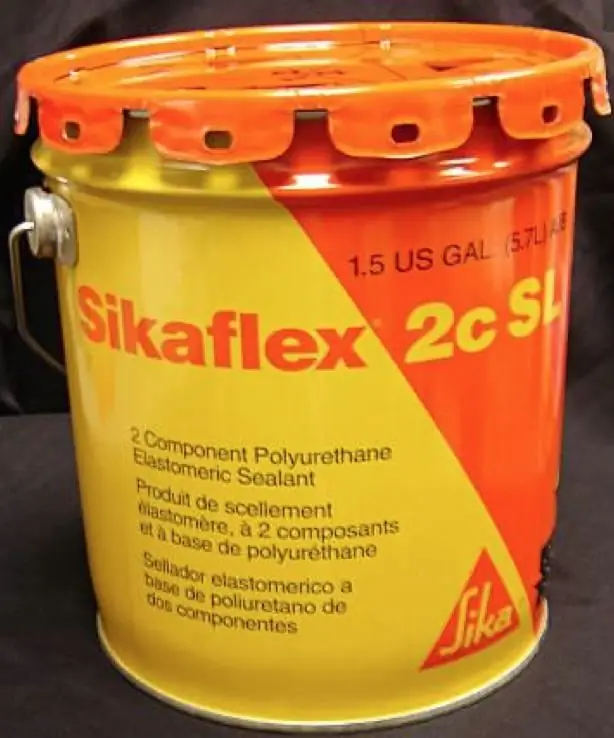2025 Author: Howard Calhoun | [email protected]. Last modified: 2025-01-24 13:10:35
Anchor chain is an important element of the anchor device and the entire vessel as a whole. The first anchor chains appeared two hundred years ago. Now the design of the anchor chain complies with standards and undergoes mechanical tests.
History of the anchor chain
For centuries, sailors have used hemp ropes to anchor anchors. The sailing ships of the middle of the last millennium were held up while anchored by small anchors, and the strength of the hemp ropes was sufficient. With the development of shipbuilding, sea-going ships and, consequently, anchors became heavier. In order to be strong enough, the hemp ropes reached half a meter in circumference, so thinner ends had to be used to wind the ropes into the bollard or encircle the drum of the spire. In addition, the hemp ropes frayed against the anchor hawse and were cut off by ice, in order to compensate for their low weight, the anchor rod had to be made heavier.

The end of the eighteenth and the beginning of the nineteenth centuries are known for isolated cases of the use of metal anchor chains, which proved themselves remarkably well both during storms and during ice drift onThames. The official beginning of the use of the metal chain is considered to be 1814.
The frigate "Pallada", launched in 1832, is the first ship of the Russian fleet equipped with anchor chains.
Already in 1859, before being installed on ships of the British Navy, anchor chains began to be tested for tension in accordance with the requirements developed by Lloyd's Register, and in 1879 - for breaking.
Requirements of the Register of Shipping
The Russian fleet began to develop especially rapidly at the beginning of the 20th century, and the classification of ships that existed at that time ceased to meet safety requirements. Therefore, in 1913, the national classification society "Russian Register" was formed, which in Soviet history became known as the Register of the USSR, and now - the Russian Maritime Register of Shipping (RS). Its tasks include measuring and classifying ships and floating structures, maintaining their registers, monitoring them and technical supervision.
According to the requirements of the Register, sea-going vessels must have two working anchors and one spare sea anchor. In this case, the length of each chain must be at least two hundred meters, a spare anchor bow is provided. As well as two connecting links and an end bracket. The anchor device of the ship provides mechanisms, the power of which allows you to choose anchors in no more than half an hour. Components of an anchor device are subject to the Register's supervision.

Anchor device
The anchor attached to the chain is released or raised using special mechanisms and devices. Anchors, chains, stoppers, devices for releasing the root end of the chain, hawse - all this together makes up the anchor device of the ship. It is located in the bow of the vessel with two anchors along the sides. A winch with electric or hydraulic drive is also installed on the bow. The main part of the winch is the sprocket, on which the chain links are wound. The design of the winch also includes drums on which mooring lines are wound.

The chain from the anchor passes through the recess in the side, the anchor hawse and the stopper, is wound on the winch sprocket and is attached with a bracket to the vessel in the chain box with its free end.
Stern anchor devices are installed on some ships. Since space is limited at the stern, a capstan is used to lift one or two stern anchors. This is a rotating drum with an asterisk at the bottom, mounted vertically. It is driven by an electric motor, which can be located either in the drum itself or below deck. A chain is wound on the sprocket. The photo shows the capstan arrangement, where 1 is a drum, 2 is a horizontal sprocket, 3 is an anchor chain.

Retaining and fasteners
Stops secure, prevent spontaneous etching and hold the chain and anchor in the clewse in a taut position. They can be stationary or portable: chain and deck.
According to the design, the stoppers are screw cam or with a mortgage link. Eccentric locks are installed on small craft. Chain stoppers are short bows thatare passed through the anchor bracket and attached to the butts on the deck with two ends.
Anchor fairleads, which serve to clean the anchor and anchor chain, can be ordinary, welded or cast for transport and fishing vessels; open in the form of a massive casting with a chute on low-sided vessels; with a niche in the side plating on passenger ships, ice navigation vessels, allowing the anchor to be removed flush with the hull, thereby reducing the risk of damage.
Types and designs of anchors
Today there are four types of anchors. With the help of dead anchors, which are located in the bow, the vessel is held in place. Their maximum weight on aircraft carriers reaches 30 tons. Auxiliary anchors at the stern are intended to prevent the vessel from turning around the station. For long-term retention, floating objects, such as buoys or lighthouses, are fixed with "dead" anchors. Imports are held by special purpose ships, the so-called. ships of the technical fleet for mining.

Today, more than five thousand types of anchors are known in the world. But the sea anchor consists of four main parts. The basis of the whole structure is the spindle. Horns with paws are fixed on the spindle or on a hinge, which burrow into the ground and hold the ship in place. A rod is located perpendicular to the horns and spindle, which turns the anchor over at the bottom after immersion and prevents the horns from lying horizontally. Anchor fastening to a rope or anchor chain is provided by a bracket and a ring called an eye.
Basic elements of the anchor chain
The main element of the anchor chain is the link, which is either forge-welded steel bar with a cast-iron buttress or cast together with a mild steel brace.
The bows of the anchor chain are connected by connecting brackets, simple or patented, the most common of which is the Kenter bracket. Simple staples are not immune from spontaneous opening. In addition, when using them, the end links of the bows are made without buttresses and are larger than ordinary links.
Kenter's bracket is similar to a regular link, only detachable. The two halves of the bracket are connected into a lock and held by a spacer into which a pin with a lead plug is inserted at an angle.
The swivel, which prevents the anchor chain from twisting while at anchor, is usually a construction of the swivel itself, the end link and two reinforced links between them.
Reinforced link - with a buttress, smaller in size than the end link, but larger than the usual link. The anchor bracket is inserted into the eye of the anchor spindle, it is also connected to the end link of the swivel with an anchor bracket turned back to it.
Anchor chain design
The anchor chain, like any other, consists of links, but the design is not so simple. The links are assembled into segments of a certain length, which are called intermediate bows. According to the standards of the Russian fleet, the length of the bow is 25 meters, in the British, where the measurement of length in yards is accepted - 27, 43 meters or 30 yards. Bows to desired chain lengthare assembled and interconnected by Kenter links. This assembly method makes it easy to remove damaged areas and change the length of the anchor chain if necessary.

The root bow, which is fixed in the chain box, ends with an end bracket on the one hand, and is reinforced with a zhvakogals on the other. The zhvakogalsovy bow is a short chain fixed at one end in a chain box and with a hook at the other end. The photo shows that it is possible to release the toe of the hinged hook. This design allows one person to quickly release the vessel from the anchor chain.
The anchor bow (running end) also differs in design from the intermediate ones. It includes a swivel. And the bow ends with a bracket to which the anchor is attached.
Anchor chain dimensions
The main size that determines the thickness and characteristics of the chain is its caliber. Caliber - the diameter of the bar from which the link is made, or the end section of the link, depending on the method of its manufacture. Other dimensions of the links that make up the chain are also expressed through the caliber.

The weight of a running meter of an anchor chain is also calculated depending on the caliber using coefficients: for a long chain - 2, without buttresses - 2, 2, with buttresses - 2, 3.
The length of the chain depends on the type of vessel and its dimensions. It must be much greater than the depth of the sea at the anchorage, because, firstly, the gravity of the part of the chain lying on the bottom helps the anchor to lie down on the bottom and hold it there, and secondly, the forcewhich acts on the anchor when hooked to the bottom, should not be directed upwards, but horizontally.
Sea ships usually have anchor chains consisting of 10-13 bows with a caliber of 80 to 120 mm, which depends on the size of the anchor. If the caliber is more than 15 mm, then the links are made with a buttress - a transverse jumper, which increases the strength of the link by more than 20%.

In addition to special counters, color marking is used on anchor devices. The number and color (white or red) of the painted links depend on the number of etched meters or bows that make up the chain. The photo shows that one hundred and forty meters of the chain have been etched, since two links are painted white on both sides of the red Kenter bracket. To determine the length of the chain in the dark, a benzel of soft annealed wire is superimposed on the buttress of the last link before the painted one.
Anchor chain parameters
The main parameters of the anchor chain are caliber, strength category, mechanical tensile loads and trial theoretical weight. According to the design parameters, the links of the anchor chain come with and without buttress.
According to the strength characteristics, which depend on the caliber, material and manufacturing method, the anchor chain can be normal, high or high strength. Chains can also differ in the way the links themselves and spacers are made.

Compliance with production standards is a prerequisite for the manufacture of anchor chains. For example, an anchor chain GOST 228-79 is a product with spacers, which is made of carbon and alloy steels, has approved mechanical properties, has a degree of strength of three categories and a caliber of the main links with a spacer from 11 to 178 mm.
The quality of mechanisms, components and individual parts of anchor devices, including chains, is not only the reliability and safety of the vessel, but also a guarantee of safety, and sometimes the lives of people on board.
Recommended:
Ochkarik chain of stores: reviews, features and assortment

Not all people can boast of excellent vision, because modern life is associated with a large number of irritating factors for the eyes. Opticians offer a wide range of glasses and lenses, among which you can choose the right option. In this article, we will talk about the Ochkarik chain of stores, analyze the main features and study customer reviews
Aircraft device for dummies. Aircraft device diagram

Few people know how an airplane works. Most don't care at all. The main thing is that it flies, and the principle of the device is of little interest. But there are people who cannot understand how such a huge iron machine rises into the air and rushes at great speed. Let's try to figure it out
Two-component adhesive (epoxy, polyurethane)

Two-component adhesive - a group of high-quality adhesives that do not contain solvents. The main components are resins (binders) and hardeners (separately stored, can be either in the form of a suspension or in powder)
Two-component polyurethane sealant: definition, creation, types and types, characteristics, properties and nuances of application

With long-term and high-quality sealing of seams and cracks, polyurethane two-component sealants have found their wide distribution. They have high deformation and elastic properties, therefore, they can be used as butt sealants in the field of repair and housing construction
Cor. an account is an important component of bank settlements

Correspondent, or the so-called "correspondent account", is an account on which all types of operations of one bank, performed in accordance with a correspondent agreement, are recorded and subsequently displayed. In other words, this concept is used to form reserve funds or various transfers made by the aforementioned structure

